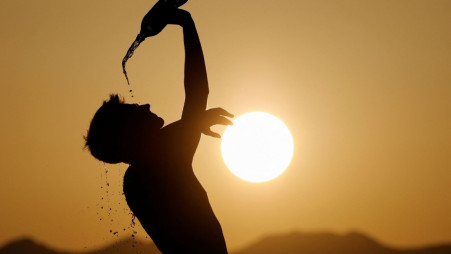Dhaka heats up — gets 1.4°C warmer in four decades as green cover shrinks
Between 1980 and 2023, the city lost 47% of its dense greenery due to urban expansion, raising its maximum temperature faster than the national average of 1.1°C.

Capital city Dhaka has warmed by 1.4°C over the past four decades, which translates into a 2.9°C rise in "feels-like" temperature measured by the heat index, according to a World Bank-sponsored survey.
The report links the surge to shrinking vegetation coverage and the rapid spread of heat-trapping concrete structures that make the surface warmer.
Between 1980 and 2023, the city lost 47% of its dense greenery due to urban expansion, raising its maximum temperature faster than the national average of 1.1°C.

This hotter air caused residents to experience 7.7% more heat stress in 2023 compared to 1980, notes the survey titled An Unsustainable Life: The Impact of Heat on Health and the Economy of Bangladesh.
While Dhaka's overall heat index increase during this period remained slightly below the national average due to reduced humidity, the pace has sharply accelerated in recent years—rising 0.3°C annually during 2015–23, well above the national trend of 0.2°C.
Researchers attribute the spike to the "urban heat island" (UHI) effect, where concrete-heavy development, reduced airflow, waste heat from vehicles and cooling devices, and loss of natural cooling sources make cities hotter than surrounding areas. Consistent with global trends, July emerged as Dhaka's hottest month.
The heat index, which combines air temperature and humidity, reflects how the human body suffers from high humidity and slow sweat evaporation, intensifying heat stress and raising risks for health and productivity, the report warns.
Factors contributing to the UHI effect may include reduced coverage of naturally cooling vegetation and water bodies, higher use of heat-absorbing and heat-retaining building materials, reduced air circulation from densely built infrastructure, and higher output of anthropogenic heat sources, such as waste heat from vehicles and cooling devices, the report quotes from another study.

The World Bank's report also cited previous studies that showed a reduction in the proportion of healthy vegetation in Dhaka from 5,202 hectares or 17% in 1989 to 612 hectares or 2% in 2020. With rapid expansion of urban settlements, the city's green spaces were fragmented, declining to around 5,600 hectares from 12,745 hectares during the period. The total city area increased by 19% between 2001 and 2017, but the total population residing in Dhaka city increased by almost 77% at the same time, it states.
The report, authored by Iffat Mahmud, Wameq Azfar Raza, and Syed Shabab Wahid, refers to South Asian cities where the use of heat-trapping building materials keeps indoor air temperature higher at night than during the day, particularly in tin-roofed structures—causing harm to human health.
As Dhaka's heat index is about 65% higher than the national average, the impacts are far-reaching on health and economy, warns the report. However, it says, there is still a way out.
"The good news is that it can be done, as seen in countries like Singapore and others," said Jean Pesme, World Bank Division Director for Bangladesh and Bhutan. Bangladesh can build on its experience in climate adaptation and take a coordinated approach across sectors to address the heatwave impacts and maintain sustainable growth, the Bank's executive believes.
The report suggests that building designers need to consider factors like roof and wall materials, window design and ventilation, internal and external shading, and so on to ensure that indoor spaces do not trap heat.
It calls for developing and implementing area- or city-specific heat action plans, customised to local needs, to make sure that urban structures act as a heat diminisher, not a heat multiplier.



 Keep updated, follow The Business Standard's Google news channel
Keep updated, follow The Business Standard's Google news channel

















